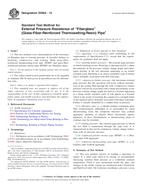We need your consent to use the individual data so that you can see information about your interests, among other things. Click "OK" to give your consent.
ASTM F2263-14
Standard Test Method for Evaluating the Oxidative Resistance of Polyethylene (PE) Pipe to Chlorinated Water
STANDARD published on 1.8.2014
The information about the standard:
Designation standards: ASTM F2263-14
Note: WITHDRAWN
Publication date standards: 1.8.2014
SKU: NS-53405
The number of pages: 8
Approximate weight : 24 g (0.05 lbs)
Country: American technical standard
Category: Technical standards ASTM
The category - similar standards:
Annotation of standard text ASTM F2263-14 :
Keywords:
chlorine resistance, oxidative resistance, pipe, polyethylene, ICS Number Code 23.040.20 (Plastic pipes)
Additional information
| Significance and Use | ||||||||||||||
|
5.1 Environment or oxidative time-to-fail data derived from this test method, analyzed in accordance with Section 13, are suitable for extrapolation to typical end-use temperatures and hoop stresses. The extrapolated value(s) provides a relative indication of the resistance of the tested PE pipe or system to the oxidative effects of chlorinated water for conditions equivalent to those conditions under which the test data were obtained. The performance of a material or piping product under actual conditions of installation and use is dependent upon a number of factors including installation methods, use patterns, water quality, nature and magnitude of localized stresses, and other variables of an actual, operating cold water supply or service system that are not addressed in this test method. As such, the extrapolated values do not constitute a representation that a PE pipe or system with a given extrapolated time-to-failure value will perform for that period of time under actual use conditions. 5.2 This test method has been generally used for evaluating oxidatively induced Stage II or Stage III failure data. |
||||||||||||||
| 1. Scope | ||||||||||||||
|
1.1 This test method describes the general requirements for evaluating the long-term, chlorinated water, oxidative resistance of polyethylene (PE), used in cold water supply or service systems by exposure to chlorinated water. This test method outlines the requirements of a pressurized flow-through test system, typical test pressures, test-fluid characteristics, failure type, and data analysis. Note 1: Other known disinfecting systems (chlorine dioxide,
ozone, and chloramine) are currently used for protection of potable
water; however, free-chlorine is by far the most common system in
use today. Disinfecting systems other than chlorine have not been
evaluated by this method.
1.2 Guidelines and requirements for test temperatures, test hoop stresses, and other test criteria have been established by prior testing of PE pipe. Other related system components that typically appear in a PE cold water supply or service system can be evaluated with the PE pipe. When testing PE pipe and fittings as a system, it is recommended that the anticipated end-use fitting type(s) and material(s) be included in the test circuit since it is known that some fitting types and materials can impact failure times. Specimens used shall be representative of the piping product(s) and material(s) under investigation. Note 2: The procedures described in this test method (with
some modifications of test temperatures or stresses, or both) have
been used to evaluate pipes manufactured from polybutylene (PB),
crosslinked polyethylene (PEX), polypropylene (PP), multilayer
(polymer-metal composite), copper, and stainless steel.
1.3 This test method is applicable to PE pipe and systems used for transport of potable water containing free-chlorine for disinfecting purposes. The oxidizing potential of the test-fluid specified in this test method exceeds that typically found in potable water systems across the United States. 1.4 The values stated in inch-pound units are to be regarded as standard. The values given in parentheses are mathematical conversions to SI units that are provided for information only and are not considered standard. 1.5 The following precautionary caveat pertains only to the test method portion, Section 12, of this specification.This standard does not purport to address all of the safety concerns, if any, associated with its use. It is the responsibility of the user of this standard to establish appropriate safety and health practices and determine the applicability of regulatory limitations prior to use. |
||||||||||||||
| 2. Referenced Documents | ||||||||||||||
|
Similar standards:
Historical
1.2.2011
Historical
1.11.2012
Historical
1.2.2012
Historical
1.8.2009
Historical
1.3.2008
Historical
1.10.2012
We recommend:
Updating of laws
Do you want to be sure about the validity of used regulations?
We offer you a solution so that you could use valid and updated legislative regulations.
Would you like to get more information? Look at this page.



 ASTM D2729-11
ASTM D2729-11 ASTM D2737-12a
ASTM D2737-12a ASTM D2774-12
ASTM D2774-12 ASTM D2846/D2846M-09..
ASTM D2846/D2846M-09.. ASTM D2852-95(2008)..
ASTM D2852-95(2008).. ASTM D2924-12
ASTM D2924-12
 Cookies
Cookies
